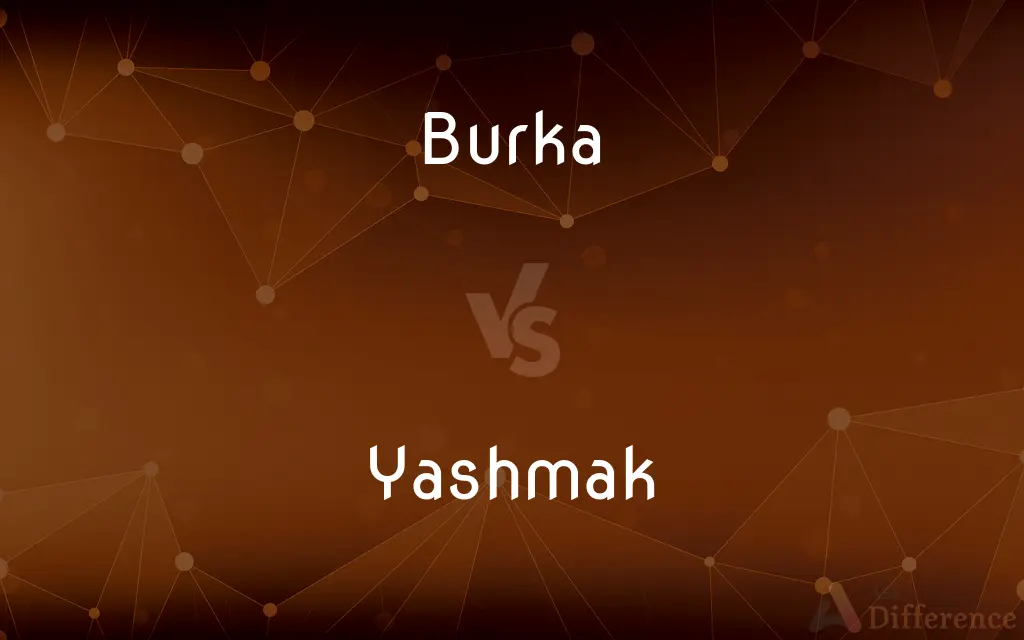Burka vs. Yashmak — What's the Difference?
By Urooj Arif & Maham Liaqat — Updated on April 25, 2024
A burka is a full-body covering worn in some Islamic cultures, covering the entire body and face, while a yashmak, or yashmac, is a type of veil covering only the face, often part of Turkish attire.

Difference Between Burka and Yashmak
Table of Contents
ADVERTISEMENT
Key Differences
A burka is an enveloping outer garment worn by women in some Islamic traditions, covering the entire body and face, including a mesh screen over the eyes to see through. On the other hand, a yashmak, also spelled yashmac, is a facial veil that covers the lower part of the face up to the eyes, traditionally worn by some Muslim women, particularly in Turkey.
The burka serves as both a cultural and a religious symbol, often seen in countries like Afghanistan and Pakistan, where it is worn for modesty in accordance with local interpretations of Islamic teachings. Whereas the yashmak is more associated with the historical and cultural attire of the Ottoman Empire and less commonly used today, it reflects a different historical and cultural context.
In terms of materials, burkas are typically made from heavier fabrics like cotton or polyester, which can obscure the wearer's shape entirely. On the other hand, yashmaks are often made from lighter, semi-transparent fabrics like lace or silk, and are designed to obscure only part of the face.
While the burka is often uniformly colored, usually in shades of blue or black, to emphasize modesty and uniformity, the yashmak can be adorned with embroidery or jewels, particularly in historical or ceremonial contexts, reflecting a variance in cultural expression through attire.
The usage of both garments varies significantly with regional, cultural, and individual beliefs about modesty and women's visibility in public spaces. The burka can be a requirement in stricter, conservative environments, whereas the yashmak has become more of a cultural symbol with less frequent use in daily life.
ADVERTISEMENT
Comparison Chart
Coverage
Full body including the face
Only covers the face, up to the eyes
Cultural Association
Common in Afghanistan, Pakistan
Traditionally associated with Turkey
Material
Heavy fabrics like cotton or polyester
Lighter, semi-transparent fabrics
Visibility
Includes a mesh over the eyes
Leaves the eyes and forehead exposed
Decorative Elements
Generally plain
Can be decorated with embroidery or jewels
Compare with Definitions
Burka
A full-body covering worn for modesty in some Islamic cultures.
She wore a blue burka when visiting the market.
Yashmak
A veil covering the lower half of the face, traditional in Turkey.
The bride wore an ornate yashmak embroidered with pearls.
Burka
Predominantly found in countries like Afghanistan.
Burkas are a common sight in the streets of Kabul.
Yashmak
Typically made from light, sometimes decorative materials.
Her yashmak was a delicate lace, barely concealing her smile.
Burka
Covers the wearer entirely including a mesh over the eyes.
The burka’s mesh panel allows the wearer to see while remaining covered.
Yashmak
Does not cover the entire body, focusing on the face.
She paired her fashionable yashmak with a modern outfit.
Burka
Worn as a symbol of religious and cultural identity.
She chose to wear a burka as a personal expression of her faith.
Yashmak
Historically associated with Ottoman fashion.
Yashmaks were common in portraits of Ottoman women.
Burka
Often made from durable, non-transparent materials.
Her burka was made of heavy black polyester.
Yashmak
Less commonly used today, mostly for ceremonial purposes.
For the heritage day, she donned a traditional yashmak.
Burka
Variant of burqa.
Yashmak
A yashmak, yashmac or yasmak (from Turkish yaşmak, "a veil") is a Turkish and Turkmen type of veil or niqāb worn by women to cover their faces in public. Today there is almost no usage of this garment in Turkey.
Burka
An Islamic garment that covers the whole body, which has a net screen covering the eyes so they cannot be seen, and is worn by women.
Yashmak
A veil worn by Muslim women to cover the face in public.
Burka
A dress made from felt or karakul (the short curly fur of young lambs of the breed of that name), traditionally worn by men of the Caucasus region.
Yashmak
A veil worn by Muslim women to cover parts of the face when they are in public.
Burka
A loose garment (usually with veiled holes for the eyes) worn by Muslim women especially in India and Pakistan;
The Taliban forced all women to wear the burqa
Yashmak
The face veil worn by Muslim women
Common Curiosities
Where are burkas and yashmaks commonly worn?
Burkas are prevalent in Afghanistan and Pakistan, whereas yashmaks were traditionally worn in Turkey.
How do the materials of a burka and yashmak differ?
Burkas are made from heavy, opaque materials, while yashmaks are often lighter and can be semi-transparent.
Can the yashmak be decorative?
Yes, yashmaks can be embellished with embroidery or jewels, especially in historical or ceremonial contexts.
Does wearing a burka affect vision?
The mesh screen over the eyes in a burka allows the wearer to see, although it may reduce visibility compared to not wearing one.
Is the burka worn for religious reasons only?
While often worn for religious reasons, the burka also fulfills cultural and societal norms in some regions.
How has the use of the yashmak evolved over time?
Historically common, the use of the yashmak has declined, transitioning more into a symbol of cultural heritage rather than everyday attire.
How do women feel about wearing these garments?
Women's attitudes towards wearing burkas and yashmaks vary widely, influenced by personal, religious, and cultural factors.
What is a burka?
A burka is a full-body veil that covers the entire body and face of the wearer, commonly used in some Islamic cultures for modesty.
What is a yashmak?
A yashmak is a type of face veil that covers the lower half of the face, traditionally worn by Muslim women in Turkey.
What does the burka signify in Islamic culture?
The burka signifies modesty and privacy, adhering to conservative interpretations of Islamic teachings regarding women's attire.
Are yashmaks still commonly worn today?
Yashmaks are less commonly worn today and are more often seen in historical or ceremonial settings.
What are the differences in the usage of a burka and a yashmak?
The burka is used for full-body coverage adhering to strict modesty requirements, while the yashmak is primarily a face veil with less comprehensive coverage.
Can a burka be colorful?
Although traditionally blue or black, burkas can vary in color depending on regional and personal preferences.
Is the yashmak tied to any religious teachings?
The yashmak does not have a specific religious mandate but is influenced by cultural interpretations of modesty in Islam.
How do burkas and yashmaks reflect cultural identity?
Both garments serve as cultural symbols, reflecting the norms and values of the societies in which they are worn.
Share Your Discovery

Previous Comparison
Start vs. Launch
Next Comparison
Mall vs. MaulAuthor Spotlight
Written by
Urooj ArifUrooj is a skilled content writer at Ask Difference, known for her exceptional ability to simplify complex topics into engaging and informative content. With a passion for research and a flair for clear, concise writing, she consistently delivers articles that resonate with our diverse audience.
Co-written by
Maham Liaqat













































